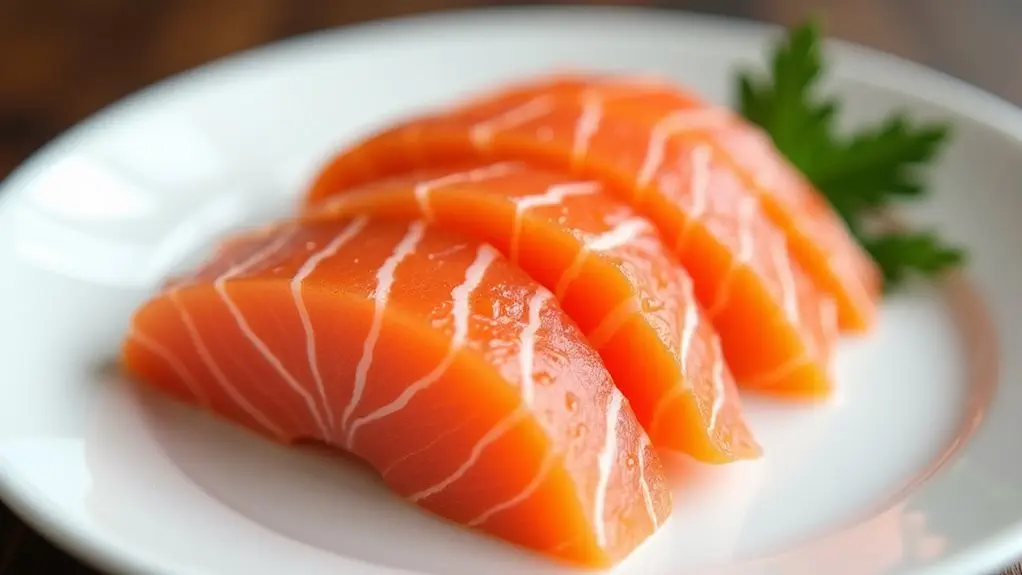For your first raw fish experience, you can't go wrong with salmon and tuna – they're like the training wheels of sushi! These fish offer mild, buttery flavors that won't overwhelm your taste buds, and they're generally safer options when properly sourced. Tuna naturally resists parasites, while farmed salmon provides consistent quality and safety. You'll want to stick with trusted suppliers who follow proper freezing guidelines and maintain strict food safety standards. Other beginner-friendly choices include yellowtail and halibut, which offer similarly approachable textures and tastes. There's a whole ocean of flavors waiting to be discovered as your palate develops.
Contents
Understanding Raw Fish Safety
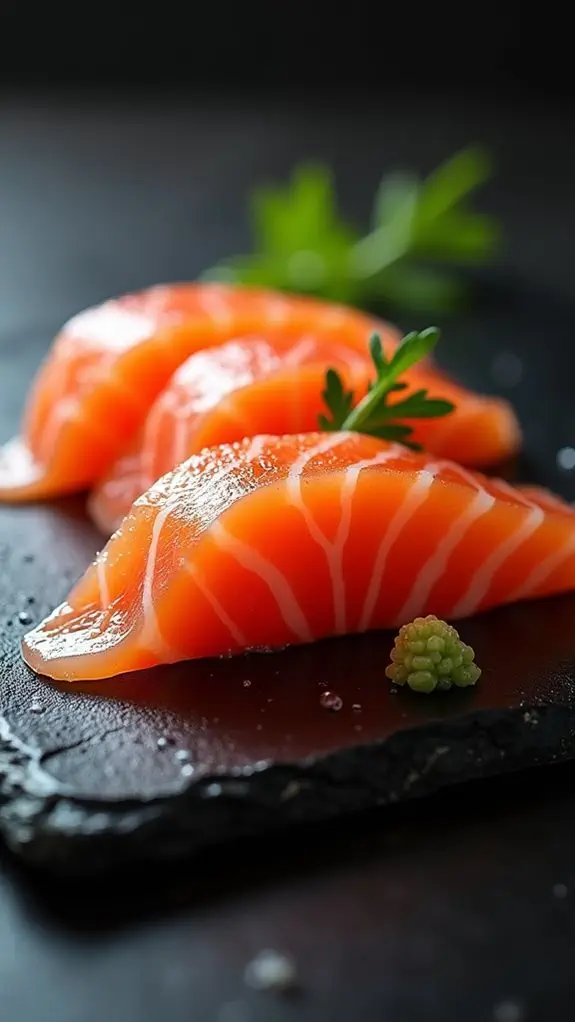
Raw fish's safety concerns should be your top priority before diving into sushi and sashimi preparation.
You'll need to understand raw fish regulations and proper food safety practices to protect yourself and your loved ones from foodborne illnesses.
First, remember that not all fish is created equal when it comes to raw consumption. Bacteria can multiply rapidly in raw seafood that is not properly iced during transport. If you're planning to eat fish raw, you'll want to freeze it at specific temperatures (-20°C for 7 days or -35°C for 15 hours) to eliminate those pesky parasites that might be lurking inside. The CDC strongly recommends cooking all fish to 145°F for optimal safety.
Here's a fun fact: large tuna species are actually exempt from this freezing rule!
You'll also want to pay close attention to freshness – it's your best friend when preparing raw fish. Look for fish that's been properly handled, with clear eyes and a clean, ocean-fresh smell.
If something seems fishy (pun intended!), trust your instincts and don't risk it.
And remember, some groups should skip raw fish altogether, including pregnant women, seniors over 65, young children, and those with weakened immune systems.
When in doubt, following proper handling guidelines and choosing sushi-grade fish from reputable suppliers will help keep you safe and satisfied.
Top Raw Fish Choices
When you're ready to try raw fish for the first time, you'll want to start with options that are both safe and approachable for your palate.
Salmon and tuna are excellent gateway choices, as they're familiar flavors that you've probably enjoyed cooked before, and they're typically prepared with food safety as a top priority. These fish offer rich omega-3 fatty acids and a naturally buttery texture that many beginners find appealing.
You can ease into your raw fish journey by starting with these mild, buttery options that won't overwhelm your taste buds while still giving you an authentic sushi experience. When selecting fish, make sure to purchase from reputable markets that prioritize freshness and proper handling practices.
Safe and Flavorful Options
Fresh tuna stands at the forefront of safe raw fish options for beginners, thanks to its natural resistance to parasites and minimal processing requirements.
Remember to purchase from reputable fish markets that receive regular shipments to ensure the highest quality and safety.
With its rich, meaty flavor profiles and cultural significance in sushi traditions, tuna offers you a delicious entry point into the world of raw fish.
You'll find that salmon is another excellent choice to start your raw fish journey. Its buttery texture and mild taste make it incredibly approachable, especially if you're feeling a bit nervous about eating raw fish.
When you're selecting salmon, opt for farmed varieties since they're typically safer than wild-caught options.
If you're ready to expand your horizons, yellowtail (hamachi) delivers a wonderful buttery flavor that's not too overwhelming. Immediate icing after catch helps maintain its premium quality and taste.
You'll notice its firm texture and versatility in various sushi preparations.
For even milder options, both halibut and snapper offer sweet, delicate flavors that won't challenge your palate.
They're perfect when served as nigiri or sashimi, and their firm textures make them easy to handle with chopsticks.
Preparing Your First Bite
Now that you're familiar with safe fish options, let's focus on preparing your first raw fish experience. For the best tasting experience, start with mild, buttery fish that won't overwhelm your palate. Salmon and yellowtail are excellent choices, offering delicate textures and approachable flavor profiles that'll make you feel like a sushi pro from the first bite.
When preparing your fish, slice it into thin, manageable pieces using a sharp knife. You'll want to keep everything ice-cold and impeccably clean – think of yourself as a sushi chef in training! Using separate cutting boards for raw fish helps prevent cross-contamination with other foods. The rice vinegar mixture is essential when preparing sushi rice to achieve that perfect balance of flavors.
Start with a simple nigiri or sashimi preparation, which lets you fully appreciate the fish's natural flavors without any distractions.
Remember to examine your fish carefully before serving. It should have a fresh, clean smell and a vibrant color that makes your mouth water.
If you're feeling a bit nervous (totally normal, by the way!), try starting with tuna – it's the gateway fish of the raw seafood world. Its firm texture and mild taste make it perfect for first-timers, and you'll be amazed at how different it tastes from the canned stuff!
Essential Handling Tips
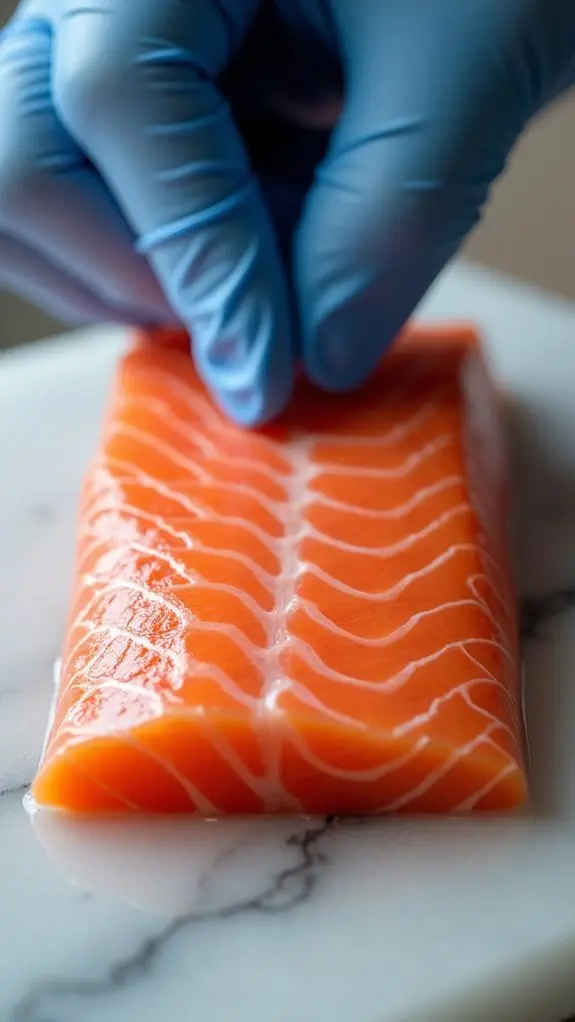
Mastering three key aspects of raw fish handling will guarantee both safety and quality in your seafood preparation.
First, you'll need proper storage – always keep your fish ice-cold between 35-40°F (2-4°C). Don't let that beautiful piece of fish sit out on your counter while you're chatting on the phone! Get it into the fridge right away, wrapped tightly in plastic and sealed in a storage bag. Look for fish with bright eyes and gills that appear healthy when making your selection. Fresh fish is essential for dishes like ike jime preparation, which helps maintain optimal texture and flavor.
When it comes to fish selection tips and hygiene practices, you'll want to create a spotless workspace. Think of your kitchen as a mini sushi bar – keep those cutting boards and knives squeaky clean with hot, soapy water.
And yes, you'll need to wash your hands thoroughly before and after handling raw fish (no shortcuts here, future sushi master!).
For raw consumption preparation, remember that freezing isn't just for storage – it's an essential safety step. You'll need to freeze certain fish like salmon at specific temperatures to eliminate parasites.
Once thawed, handle your fish gently and keep it away from sunlight. Remember, what happens in the prep stage makes all the difference in your final dish.
Sustainable Fish Selection
When you're starting your raw fish journey, you'll want to look for trusted certification labels like MSC (Marine Stewardship Council) and ASC (Aquaculture Stewardship Council) to guarantee your seafood comes from responsible sources.
Your best bet is to choose fish caught using ocean-friendly methods like pole-and-line fishing, which won't harm other marine life or damage the seafloor.
Supporting local fisheries and markets not only gives you fresher options but also lets you build relationships with suppliers who can tell you exactly where and how your fish was caught.
Trusted Certification Programs
Steering through the world of sustainable seafood becomes much simpler when you understand certification programs.
When you're starting your raw fish journey, certification importance can't be overstated – it's your assurance that you're making responsible choices for both your health and the environment.
Look for trusted labels like MSC for wild-caught fish and ASC or BAP for farmed options.
These certifications aren't just fancy stickers – they're your confirmation that the fish has been sourced responsibly and handled properly from ocean to plate.
The seafood transparency these programs provide helps you make informed decisions about what ends up on your sushi plate.
You'll often spot these certification labels at quality seafood markets and sushi restaurants.
The MSC's blue fish label, for instance, tells you that your wild-caught fish meets strict sustainability standards.
Meanwhile, ASC and BAP certifications confirm that farmed fish are raised without harmful antibiotics and with minimal environmental impact.
Think of these certifications as your friendly guides in the sometimes-overwhelming world of seafood selection – they're there to help you choose wisely and eat confidently.
Ocean-Friendly Fishing Methods
Understanding ocean-friendly fishing methods is essential as you begin exploring raw fish options. When you're selecting raw fish for your first sushi adventure, you'll want to know how it was caught using sustainable techniques that protect our oceans and marine life.
Look for fish caught through trolling, which uses individual lines and hooks – it's like the difference between catching one fish at a time versus casting a giant net! This method is particularly great for tuna and salmon, giving you high-quality fish while keeping other marine creatures safe.
Bottom long-lining is another excellent choice, as it's designed to target specific fish species while allowing non-target catches to swim away unharmed.
You'll also want to pay attention to fishing regulations in different regions. Some areas have stricter rules about catching methods, which actually works in your favor as a raw fish beginner. These regulations guarantee you're getting fish that's not only sustainably caught but also properly handled from ocean to plate.
When shopping, look for labels that indicate the use of turtle excluder devices and circle hooks – these simple tools make a big difference in protecting our ocean friends!
Local Sourcing Benefits
For beginners venturing into raw fish preparation, local sourcing offers compelling advantages that extend far beyond just freshness. When you're starting out with raw fish dishes, you'll want to build a strong foundation of trust with your seafood sources, and there's no better way to do that than going local.
Local sourcing means you'll get fish that's traveled shorter distances, which not only guarantees peak freshness but also helps reduce the carbon footprint of your seafood choices. You'll find that locally sourced fish often comes with complete transparency about fishing methods and handling practices – something that's super important when you're planning to eat it raw!
Plus, you're supporting your local fishing communities while promoting seafood sustainability.
Another fantastic benefit is the connection you'll build with local fishmongers. They can become your go-to experts, offering valuable advice about seasonal availability and helping you choose the freshest catches.
They'll often share preparation tips and can tell you exactly when their fish arrived, which is essential information for raw fish preparation. Think of them as your personal seafood sustainability guides!
Proper Storage and Preparation
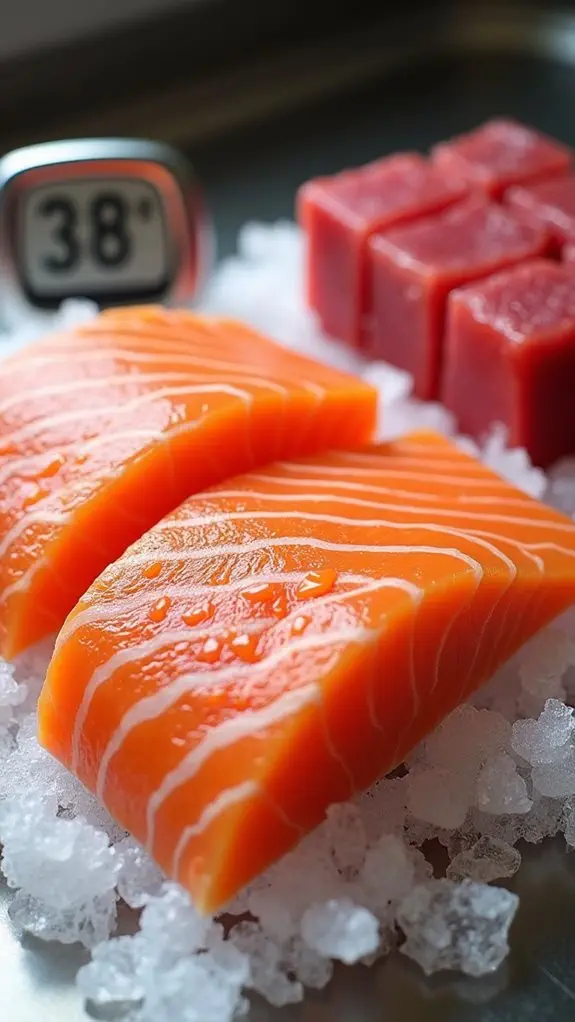
Safe storage and preparation of raw fish begins with proper temperature control and cleanliness. When you're storing your fish, remember that temperature is your best friend – keep it as cold as possible without freezing.
Your storage techniques should include placing fish in a single layer within airtight containers or zip-top bags, making sure you've squeezed out all that pesky air that can affect flavor.
For the best results with fish freezing, you'll want to follow FDA guidelines, especially if you're planning to eat it raw. Fresh fish should be cleaned and stored on the bottom shelf of your fridge, where it'll stay consistently cold.
Don't forget to use ice packs or crushed ice to maintain freshness, but make sure there's proper drainage to prevent water from pooling around your fish (nobody likes a soggy surprise!).
Remember to keep your prep area spotless and your tools clean – this isn't the time to take shortcuts! If you're handling raw fish, keep it separate from other foods to avoid any cross-contamination.
You've got about two days to use cleaned fish stored in the fridge, so plan accordingly.
Raw Fish Taste Guide
Three key factors influence your raw fish experience: flavor intensity, texture, and richness. When you're just starting to explore raw fish varieties, it's smart to begin with milder options that won't overwhelm your taste preferences.
Tuna and salmon are excellent gateway choices for beginners. You'll find tuna offers a meaty, firm texture that's surprisingly satisfying, while salmon delivers a buttery, slightly sweet flavor that's easy to enjoy.
If you're looking for something even more delicate, rainbow trout and snapper are your friends – they're mild and won't challenge your palate too much.
For those who want to investigate texture variations, yellowtail provides an interesting middle ground. It's firm like tuna but carries that luxurious, buttery mouthfeel that makes raw fish so appealing.
Sea bass and halibut are also fantastic options, offering light, delicate flavors that won't make you feel like you're taking a thorough exploration into the ocean.
Health Benefits and Risks
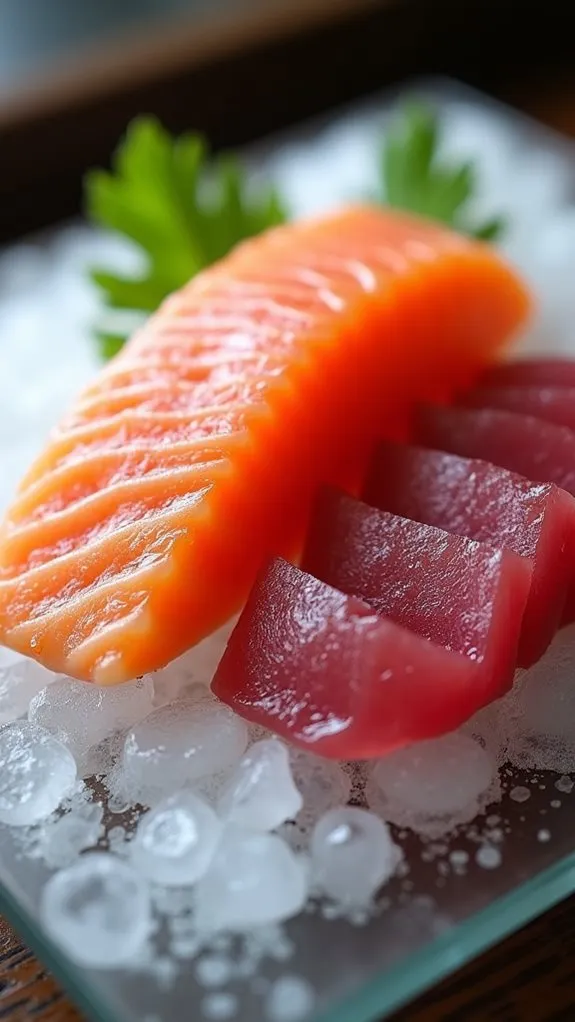
While exploring different raw fish varieties can be exciting, understanding both the rewards and potential dangers is vital for your health. Raw fish offers impressive nutritional benefits, containing higher levels of omega-3 fatty acids than its cooked counterpart.
Plus, you'll appreciate its cultural significance when enjoying traditional dishes like sushi and sashimi that celebrate centuries-old culinary practices.
However, you'll need to weigh these benefits against some serious health considerations. Here's what you should keep in mind:
- Your immune system matters – if you're pregnant, elderly, or have a compromised immune system, you'll want to avoid raw fish due to infection risks.
- Quality is non-negotiable – always buy from trusted sources that follow FDA guidelines to minimize your exposure to harmful bacteria.
- Proper preparation is essential – freezing fish at -4°F for a week kills parasites and makes your raw fish experience much safer.
When it comes to nutritional comparison, raw fish generally retains more nutrients than cooked varieties.
However, you'll want to limit your consumption frequency to avoid accumulating toxins like mercury and POPs. Remember, while that perfectly prepared sashimi might be calling your name, moderation is key to enjoying it safely.
Tools and Equipment Needed
Before diving into raw fish preparation, you'll need to gather the right tools and equipment to guarantee proper handling and food safety. The most important item you'll want is a quality knife – while traditional sushi knife types like the yanagiba are excellent, a sharp western-style chef's knife will work just fine for beginners.
Don't forget to grab a sturdy cutting board dedicated solely to fish preparation!
Your next must-have is a bamboo mat, which you'll use for rolling perfect sushi. While bamboo mat techniques might seem tricky at first, you'll get the hang of it with practice.
You'll also need a wooden bowl for mixing your sushi rice and a rice cooker to make the cooking process foolproof (trust me, perfectly cooked rice makes all the difference).
For food safety, make sure you've got proper storage containers and a reliable refrigerator to keep your fish fresh.
And here's something many beginners overlook – you'll need a freezer that can maintain the proper temperature to kill potential parasites. Think of it as your fish's cozy winter retreat before it becomes your delicious dinner!
Frequently Asked Questions
How Long Can Raw Fish Stay Fresh in the Refrigerator?
You'll want to follow fish safety guidelines and keep fresh fish storage limited to 1-2 days in your refrigerator at 40°F or below. Don't exceed this timeframe to maintain safety and quality.
Can Pregnant Women Eat Certain Types of Raw Fish Safely?
No, you shouldn't eat any raw fish during pregnancy. According to pregnancy guidelines, even high-quality raw fish poses risks. Instead, choose safe fish options like fully cooked sushi rolls heated to 145°F.
What's the Best Way to Thaw Frozen Sushi-Grade Fish?
For ideal sushi preparation, you'll want to thaw your fish slowly in the refrigerator overnight, wrapped in paper towels on a wire rack. If you're short on time, use an ice bath for 15-30 minutes.
Where Can I Find Reliable Sushi-Grade Fish Suppliers Near Me?
You'll find reliable sushi-grade fish at local markets with positive health ratings and good reviews. If you can't find any nearby, try trusted online retailers that specialize in shipping fresh, sushi-grade seafood.
Should Raw Fish Be Served at Room Temperature or Chilled?
You shouldn't serve raw fish at room temperature due to health considerations. Always serve it chilled below 40°F (4°C). The proper serving temperature prevents bacterial growth and helps maintain both safety and quality.
Final Thoughts
Starting your raw fish journey doesn't have to be intimidating. You've now got the knowledge to select safe, delicious options like salmon and tuna, handle them properly, and store them correctly. Remember, it's all about building confidence step by step. With the right tools and techniques you've learned, you'll be mastering raw fish preparation in no time. Just keep practicing, stay mindful of safety, and don't forget to enjoy the adventure!

